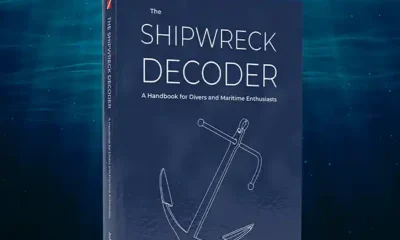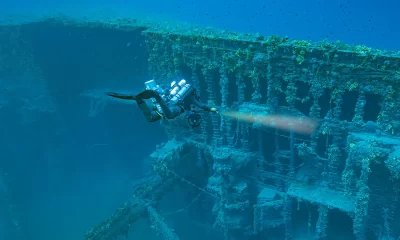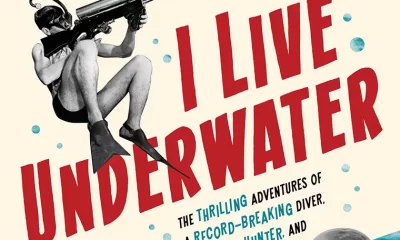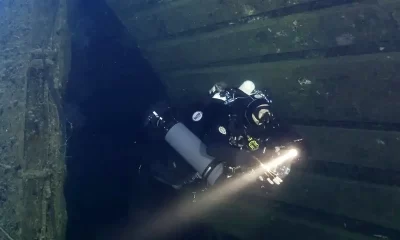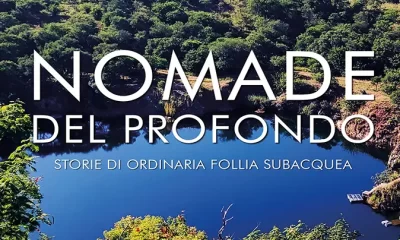Community
The Frontier Below
The Past, Present and Future of the Quest to Go Deeper Underwater
HarperCollins GB, ISBN-13: 978-0008532734
A JOURNEY TO THE BOTTOM OF THE OCEAN TOLD THROUGH HISTORY

The Frontier Below recounts the 2,000 year history of the human quest to go deeper underwater. Starting in antiquity, with pearl divers and sponge divers, it reveals many of the myths surrounding early diving, then explains how, during the Renaissance, people got serious about finding ways of breathing underwater. Maynard details the improvements to diving bells as they evolved over 400 years, again revealing many misconceptions which have been held about pioneers such as astronomer Sir Edmond Halley.
Diving helmets and diving suits were around for well over a century before English brothers John and Charles Deane developed the iconic copper diving helmet and ‘standard diving dress’ which transformed the way people worked underwater at a time in history when it was needed—the Industrial Revolution. With people working deeper new problems arose and we entered the 20th century with scientists trying to discover ways to overcome the crippling ‘bends’, and inventors attempting protect divers with iron ‘atmospheric diving suits’.
In terms of the distance from the surface to the deepest point of the ocean, by the 1920s humans had travelled less than two percent of the way, but all that was about to change.
While explaining the science behind the inventions and technology, Maynard concentrates on telling the stories of the people who instigated the breakthroughs that opened up the underwater world. Jacques Cousteau helped invent the Aqualung scuba system during World War II. Soon after he became involved with Auguste Piccard, a Swiss inventor who had built an ‘underwater balloon’ meant to take people straight down and up, much like a hot air balloon but in reverse. The disagreements between Piccard and Cousteau led to a rivalry that resulted in competing French and Italian bathyscaphes reaching depths of the two, three and four kilometres in the 1950s. When the Americans became involved, they sponsored one of the bathyscaphes in an effort to study deep sea sound channels for their nuclear submarines. This led to the deepest point of the ocean being reached nine years before people walked on the moon.
We now have the technology to exploit the seabed and mine the rare earth minerals and other resources found there. The Frontier Below uses history to bring awareness to the opportunities and threats we face in the future as a result of our ability to enter a world that was, until recently, an alien one.
Many books have been written about the history of climbing Mount Everest, reaching the North and South Poles, or landing on the moon. In The Frontier Below, Jeff Maynard presents enthralling account of discovery that takes the reader into the history of reaching the bottom of the ocean.
Jeff Maynard is an Australian author and documentary maker. He is a member of the Explorers Club, and a founding member of the Historical Diving Society. His non-fiction books include The Unseen Anzac, Antarctica’s Lost Aviator and Niagara’s Gold. He can be reached via jeffmaynard.net
What the reviewers are saying about The Frontier Below:
A brisk tour through the history of diving and submersibles. The cast of characters is wide and wild – The International Journal of Science
Maynard has given us a tour of the horizon on the history and practice of mankind’s quest to go ever deeper in the sea – Don Walsh, the first person to reach the bottom of the Mariana Trench.
On every page of this book there is a ‘I-didn’t-know-that’ moment – Sydney Daily Telegraph
Keeps you turning each page, diving deeper into history – Melbourne Herald Sun
UNDERWATER BOOK LAUNCH

“I didn’t think it would be so difficult to hold an underwater book launch,” explains author Jeff Maynard after releasing his latest book on the history of diving.
“The plan was simple. Dress in a Siebe Gorman diving helmet and suit, weight a table and lower it to the bottom of a swimming pool, then have people swim up and get a book signed.”
Maynard explains that the problems was that the books were more buoyant than he expected. He had already cut a square in the centre of each book and inserted a 1.5 kg weight from a weight belt, but it wasn’t enough. The books kept levitating off the table, even with the lead weight inside. Then the paper began to dissolve.
So how do you hold a book launch underwater?
“You need to get plastic book covers printed so the paper does not dissolve,” Maynard says.
“Then make dummy books from blocks of wood and bolt them to the table. For a book that could be opened and signed I made one from a block of wood, with a hinged plywood cover.”
The second attempt to stage an underwater book launch ran smoothly. The results can be seen on the Jeff Maynard Adventure Historian YouTube channel or at jeffmaynard.net



















